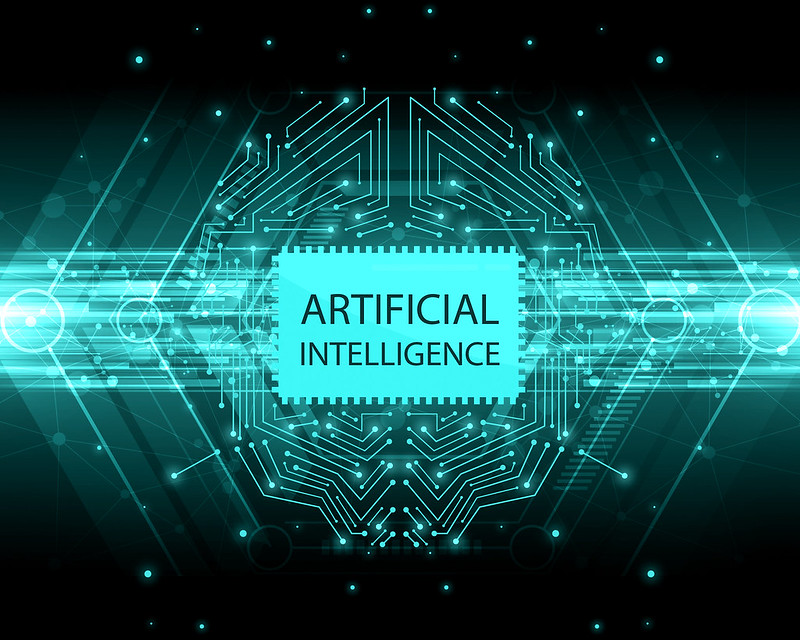A Changing Landscape: Possibilities and Cautions
Learning Objectives
By the end of this chapter, you will be able to:
- Articulate how Artificial Intelligence (AI) is changing the OER landscape.
- Consider ways that AI can assist in creating, curating, personalizing, adapting, and remediating OER content.
- Consider the challenges inherent to AI and OER practices.
- Explore AI tools for OER creation, revising, and remixing.
- Detail copyright considerations related to AI and OER.
Authors’ Note: While much of the content we’ve covered in this community has centered on previous research and guidance around open educational practices, this section of the text is relatively new territory and will evolve and change over time. As we write, this is a shifting landscape.

Artificial intelligence (AI) is transforming the landscape of OER, reshaping how they are created, discovered, adapted, and utilized in educational settings. As institutions and educators seek to expand access to knowledge, AI offers new opportunities for enhancing the effectiveness and scalability of OER. In this section, we’ll explore the intersection of AI and OER, examining the ways AI can support the development, personalization, and accessibility of open content while also considering challenges and ethical considerations.
AI in OER Creation and Curation
AI has the potential to streamline the creation and curation of OER by automating labor-intensive tasks and enhancing content quality. Key applications include:
- Automated Content Generation: AI-driven tools, such as large language models, can generate textbooks, lesson plans, and assessments tailored to specific learning objectives. These tools allow educators to create and modify content rapidly while ensuring alignment with curriculum standards.
- Enhanced Metadata Tagging: AI can analyze OER and generate more precise metadata, improving discoverability in repositories and search engines. Natural language processing (NLP) algorithms can categorize resources based on subject matter, difficulty level, and pedagogical approach.
- Translation and Localization: AI-powered translation tools such as DeepL and Google Translate can help overcome language barriers by automatically translating OER into multiple languages while adapting cultural nuances for diverse learner populations.
Personalization and Adaptive Learning
Imagine a learning experience where content could be customized for students’ learning needs in a bespoke manner. One of the most promising aspects of AI in OER is its ability to personalize learning. Consider these suggestions:
- Recommend Relevant OER: Personalized recommendations can suggest open resources based on learners’ previous interactions, academic performance, and learning preferences.
-
Adapt Learning Paths: AI-powered adaptive learning platforms such as Carnegie Learning (for K12 contexts) can tailor OER content to individual students, adjusting the complexity and pacing of materials in real time to optimize engagement and mastery.
-
Provide Automated Feedback: AI-enhanced OER can include interactive elements such as automated essay scoring, intelligent tutoring systems, and real-time feedback mechanisms that support student learning.
Accessibility and Inclusion
AI can significantly improve the accessibility of OER, making educational content more inclusive for diverse learners, including those with disabilities. The following are just some of the ways AI opens the door to a more accessible and inclusive learning environment for all students:
- Speech-to-Text and Text-to-Speech Technologies: AI can generate captions and transcripts for videos and audio-based OER, improving access for deaf and hard-of-hearing learners. Tools like Otter Voice Notes and watsonx have become game changers for supporting accessibility in educational settings.
-
AI-Generated Alternative Formats: AI can convert textual OER into alternative formats such as Braille, audio files, or simplified language versions to accommodate different learning needs.
-
Enhanced Usability with AI Assistants: AI-powered virtual assistants and chatbots can guide learners in navigating OER repositories, answering questions, and providing explanations in an interactive manner.
Ethical Considerations and Challenges
Despite the benefits AI brings to OER, several challenges and ethical concerns must be addressed. While there are multiple considerations surrounding AI–from environmental concerns to the philosophical, we’ve noted those most closely aligned with OER:
- Copyright and AI: The US Copyright Office has ruled that AI outputs are not eligible for copyright and should be considered public domain. Part 2 of the January 2025 Artificial Intelligence Report concludes that, “[T]he outputs of generative AI can be protected by copyright only where a human author has determined sufficient expressive elements. This can include situations where a human-authored work is perceptible in an AI output, or a human makes creative arrangements or modifications of the output, but not the mere provision of prompts. The Office confirms that the use of AI to assist in the process of creation or the inclusion of AI-generated material in a larger human-generated work does not bar copyrightability. It also finds that the case has not been made for changes to existing law to provide additional protection for AI-generated outputs.”
It is important to be mindful that using copyrighted materials as input for AI–if done without permission–is unethical. - Bias and Equity: AI-generated content may reflect biases present in training data, leading to issues of representation and inclusivity in OER materials.
- Data Privacy: The use of AI in personalized learning requires access to student data, raising concerns about data security, consent, and ethical use. Regulations such as the the Family Educational Rights and Privacy Act (FERPA) provide a framework for safeguarding this data.
- Sustainability and Transparency: The reliance on proprietary AI models can challenge the open ethos of OER. Efforts must be made to ensure AI-driven OER remains open, transparent, and community-driven. The Open AI white paper (2023) provides some best practices for integrating AI with OER while maintaining transparency.
A work which is not covered under copyright law, whose copyright has expired, or which has been dedicated to the public domain by its rightsholder is said to be in the public domain.

